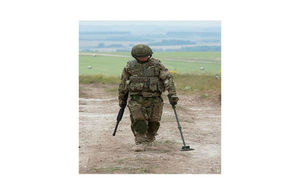Niteworks 3: Enhancing detection equipment to reduce risk to life
Conduct research into current and evolving industry capability to inform options for delivering a Future Ground Search (FGS) capability to reduce risk to loss of life.

A soldier scanning the ground using Future Ground Search equipment.
Background
Current in-service man-portable ground search detectors have been procured over time to meet specific threats and environments, often via the Urgent Operational Requirement (UOR) process. There is now an opportunity to optimise the capability to meet the future global threat environment by harnessing the latest technology available in a coordinated suite of detectors. This also offers opportunities to make improvements in the degree of stand-off between the user and the threat, as well as increasing standardisation across the suite of equipment.
Niteworks Task
Niteworks was tasked to conduct impartial research into current and evolving industry capability to inform options for delivering a ‘Future Ground Search’ (FGS) capability by identifying:
- candidate detector sensor technologies
- options to enhance stand-off
- opportunities to improve standardisation
How did Niteworks approach the task?
The Niteworks team developed an assessment scheme that enabled sensor technologies to be compared against the FGS requirement. Targeted engagement with industry gathered information on a range of technologies whilst protecting individual company intellectual property. Sensor, stand-off and standardisation options were assessed and viable options identified. These were combined to form a number of high level options, enabling the broader FGS solution space to be assessed against performance, delivery timescale and risk.
What was the outcome?
The industry focused study identified 14 sensor technologies that were considered to be viable options for the FGS detector suite, either in standalone form or in integrated combinations of 2, 3 or 4 sensors. 5 sensor technologies were identified as non-viable.
Stand-off options using active or passive sensing techniques were identified as capable of providing short to medium range stand-off detection, and an Unmanned Air System (UAS) with integrated Ground Search sensor was identified as being capable of providing long range stand-off detection. Both approaches enable detection of specific targets only, but could help reduce risk to life in some operations.
Opportunities to reduce training and logistics burdens, improve interoperability and reduce the load carried by the soldier were identified through standardising systems, interfaces and information. An industry informed perspective of how far the Ministry Of Defence should go towards implementing standards in each of these areas was identified.
Five high level options that brought sensors, stand-off and standardisation options together within a range of acquisition timeframes enabled the art of the possible to be explored. A change in performance was considered possible within the desired timescales through the introduction of new sensors; data capture and analysis techniques; UAS deployment platforms and standardisation.
What are the benefits?
MOD now has an improved understanding of the technology options for FGS, based on industry information, in order to make informed decisions on the options to take forward for further assessment.
The study has also established an informal industry engagement forum that MOD can exploit to gather further information through the FGS Concept Phase.
The resultant benefits from the study were:
- reduced risk of delay to Initial Gate due to early definition of the viable option space and informed stakeholder decision making
- more informed industry stakeholders who are better positioned to provide performance, time and cost data to support the Concept Phase
- ultimately, new equipment that will better support the ground search function and reduce risk of loss of life